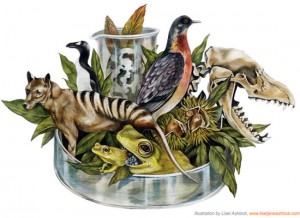Danielle Cassista: Animal Science
Paige Crowley: Animal Science
Stephen Hynes: Environmental Science
It all began in 1859, when Thomas Austin brought 24 wild European rabbits from England to Australia to use for hunting (Cox, 2012). By the 1920’s there were over 10 billion invasive rabbits inhabiting the continent of Australia and since then the population has only grown (Rabbit Free Australia, 2015). Cox (2012) stated that these rabbits reproduced in exponential quantities and currently inhabit 70% of southern Australia, which equates to 5.3 million square kilometers. These rabbits are destructive in nature; their burrowing ruins infrastructure and causes erosion, their eating destroys farmland and vegetation, and they are a threat to native species (Rabbit Free Australia, 2015). Attempts to fix the issue of the invasive rabbit species have not been successful thus far. The past solutions included releasing diseases, destroying the warrens that rabbits live in, and building a fence to keep them from spreading to other areas of Australia. None of these methods effectively eliminated the rabbit population to a manageable number (Cox, 2012). In addition, the natural predators in Australia saw a decline when the rabbit population was nearly eliminated by the released myxoma virus in the 1950s (Rabbit Free Australia, 2015). The rabbits that survived the virus built immunity, and repopulated the island, but the predators never made a significant comeback (Rabbit Free Australia, 2015). Therefore, we propose that the de-extinction and reintroduction of the Tasmanian Tiger, also known as the thylacine, into Australia is necessary to help decrease the overpopulation of rabbits, which will consequently improve agriculture and vegetation, eliminate the threat to native species, and save infrastructure. Continue Reading
![Parker, J. (2008). [Photo]. Retieved from http://witnessla.com/category/bears-and-alligators/page/3/](https://websites.umass.edu/natsci397a-eross/files/2015/04/ESA-cartoon-300x236.jpg)


Recent Comments